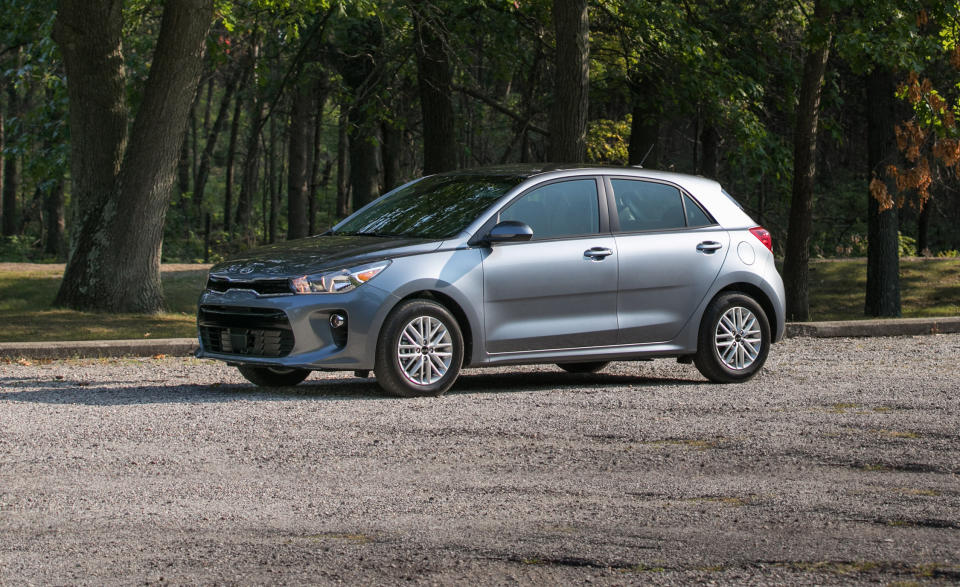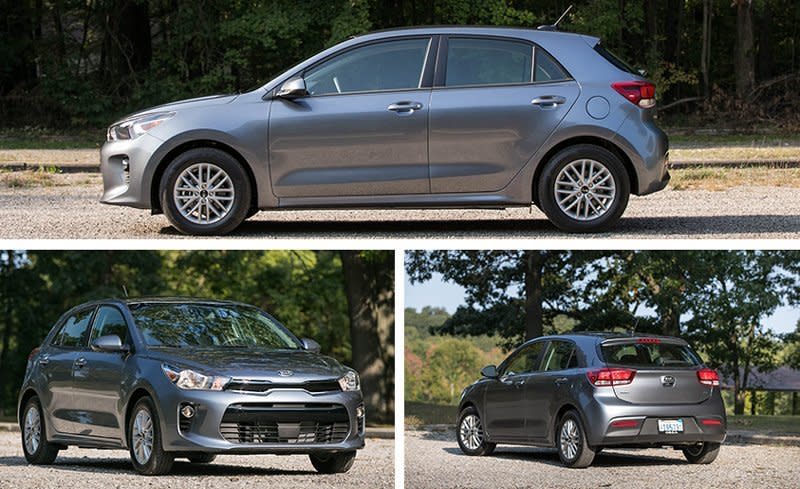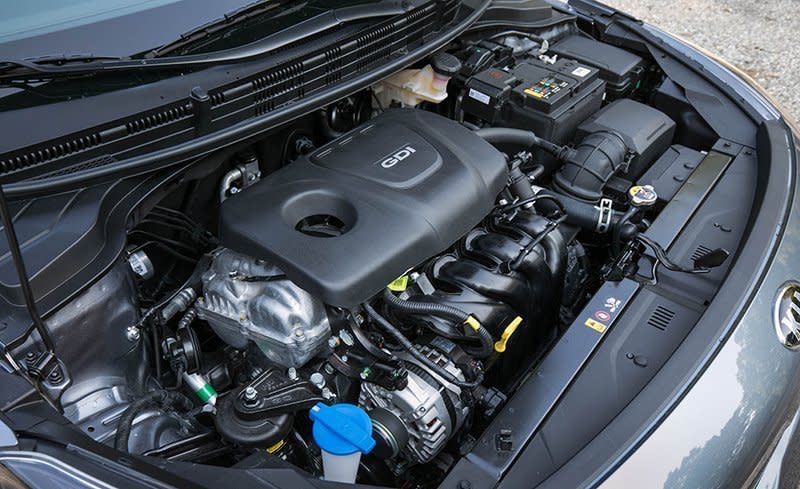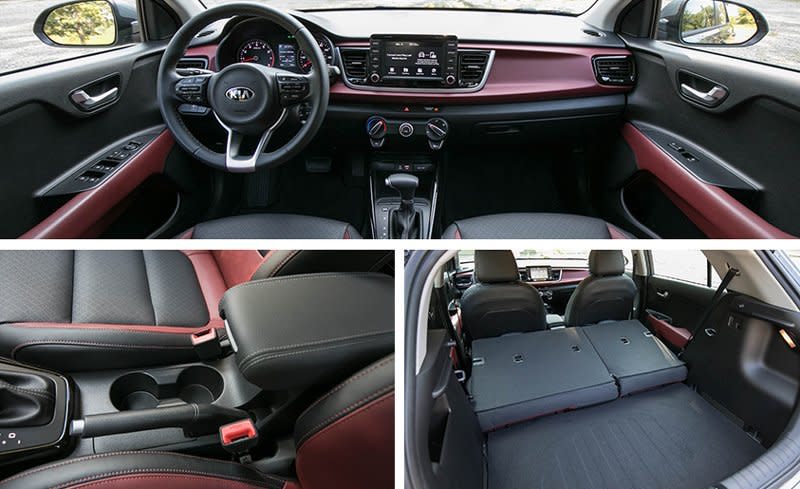2018 Kia Rio Hatchback Automatic

When you hear someone say “Kia Rio,” certain expectations follow, chief among them a small size and a low price. The newest version of the Rio, redesigned for its fourth generation in the United States, hits those marks with a sub-$15,000 starting cost and tidy dimensions. What you may not expect to find is refinement, sophistication, and a generous helping of features. That’s where the 2018 Rio delivers on the Kia brand’s tagline, “The Power to Surprise.”
Just as when it debuted in the early 2000s, the subcompact Rio remains the smallest Kia you can buy in the States. It’s available as a sedan or as the four-door hatchback tested here, and it rides on a platform shared with the Europe-market Hyundai i20 as well as the upcoming Kia Stonic and Hyundai Kona subcompact crossovers.

Purposeful Polish
Unlike earlier Rios, though, the newest ranks among the better cars to drive in its segment. While its basic chassis setup of a strut-type front suspension and a torsion-beam rear axle hasn’t changed, the new Rio’s damper tuning brings a newfound composure to the ride quality, while a stiffer structure helps the Kia absorb impacts like a more expensive car. There is not much enthusiasm to be found in the numb steering, though, and the Rio isn’t quite as sprightly as competitors such as the Honda Fit. But the Kia is significantly more poised than the tinny and buzzy Honda; we’d choose it over a Fit for a long road trip.
This more refined demeanor matches nicely with the Kia’s newly upmarket styling. Design flair is not new to the nameplate, as the previous-generation Rio was distinctive enough, but the new one makes strides in its maturity. Its exterior is perhaps less bold, but it is handsomely proportioned and nicely detailed, with a tasteful amount of chrome trim on the top-level EX. There’s something Germanic about the new Rio’s purposeful, squared-off lines, and the thick C-pillar seems like a clear nod to that paragon of hatchback design, the Volkswagen Golf.

Classy but Cramped
The Rio’s interior also is a no-nonsense, high-quality affair. Our EX test car was equipped with the $500 Launch Edition package that added flashy red accents to the dashboard and seats, but other than that, the instrument panel and dash prioritize function over form. The tachometer and speedometer flank a central LCD screen displaying trip-computer info, while a large 7.0-inch touchscreen dominates the center stack. Apple CarPlay and Android Auto are included on the EX model, although they’re not on lower trim levels with their 5.0-inch displays. The EX also is the only Rio that comes with automated emergency braking, a safety feature found on just a select few subcompacts.
Aft of the pleasant front cabin, things go downhill. The rear seat is tight on legroom and headroom; although inhabitable by two adults, the Rio’s back seat can’t hold a candle to the rear quarters found in the Fit, which is a master of space efficiency. The Honda also shames the Kia’s cargo-hauling ability—and that of nearly all other subcompact hatchbacks—with its capacious cargo hold (up to 53 cubic feet of space) and flat-folding rear seats. The Kia offers the same 17 cubic feet of space aft of the rear seats as the Honda, but folding the Rio’s seat expands that to only 33 cubes, and the 60/40 split seatbacks don’t lie flat.

Quicker and More Efficient
The Rio’s 1.6-liter direct-injected inline-four is largely the same as the engine found in the previous model. Whatever tuning updates Kia has made to the engine and the six-speed automatic transmission are definitely working, though, as the little four-banger propelled the new Rio to 60 mph in 8.5 seconds—a full second quicker than the last automatic-transmission Rio hatchback we tested. That’s despite the fact that the engine is rated at 8 fewer horsepower and 4 fewer lb-ft of torque than before, for totals of 130 hp and 119 lb-ft.
Kia also claims higher fuel economy from this revised engine, and the Rio hit an impressive 39 mpg in our 75-mph highway fuel-economy test, outperforming its EPA estimate by 2 mpg. Considering how heavy our right feet are around here, our overall average of 28 mpg with the Rio is similarly respectable.

Different Pay Grades
We do wish Kia would make the base Rio’s six-speed manual transmission available in other trim levels. It’s offered only on the stripped LX model, which forgoes so many creature comforts that it’s one of the few new vehicles still sold with crank windows. The mid-level Rio S occupies a more livable space with its reasonable load of equipment, including a backup camera, keyless entry, cruise control, and Bluetooth. And the S costs $17,295, which is a whole lot cheaper than our loaded $20,225 EX test car. (The less desirable sedan is $300 cheaper than the equivalent hatchback.)
The Rio starts to lose some appeal once it enters into that higher price range, as several significantly larger and more appealing hatchbacks—such as the Honda Civic (base price $20,775) and the Mazda 3 ($20,220)—are available for similar money. But, particularly in its more affordable lower trim levels, the new Rio presents an attractive overall package that impresses with its adept driving dynamics and perhaps the most refined ride found in the subcompact segment. It’s time to associate some new ideas with the Kia Rio.
Specifications >
VEHICLE TYPE: front-engine, front-wheel-drive, 5-passenger, 4-door hatchback
PRICE AS TESTED: $20,225 (base price: $16,185)
ENGINE TYPE: DOHC 16-valve inline-4, aluminum block and head, direct fuel injection
Displacement: 97 cu in, 1591 cc
Power: 130 hp @ 6300 rpm
Torque: 119 lb-ft @ 4850 rpm
TRANSMISSION: 6-speed automatic with manual shifting mode
DIMENSIONS:
Wheelbase: 101.6 in
Length: 160.0 in
Width: 67.9 in Height: 57.1 in
Passenger volume: 90 cu ft
Cargo volume: 17 cu ft
Curb weight: 2584 lb
C/D TEST RESULTS:
Zero to 60 mph: 8.5 sec
Zero to 100 mph: 25.0 sec
Zero to 110 mph: 37.2 sec
Rolling start, 5–60 mph: 8.9 sec
Top gear, 30–50 mph: 4.2 sec
Top gear, 50–70 mph: 6.1 sec
Standing ¼-mile: 16.7 sec @ 85 mph
Top speed (drag limited, mfr's claim): 121 mph
Braking, 70–0 mph: 182 ft
Roadholding, 300-ft-dia skidpad: 0.79 g
C/D FUEL ECONOMY:
Observed: 28 mpg
75-mph highway driving: 39 mpg
Highway range: 460 miles
EPA FUEL ECONOMY:
Combined/city/highway: 32/28/37 mpg

 Yahoo Autos
Yahoo Autos 